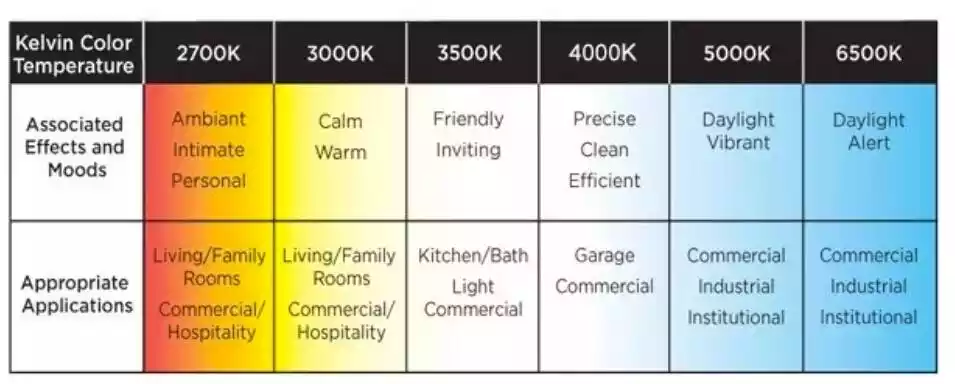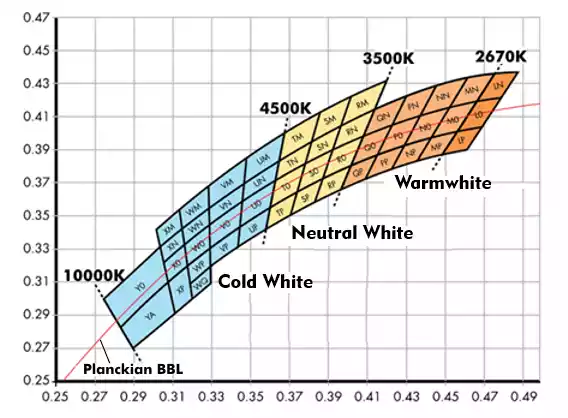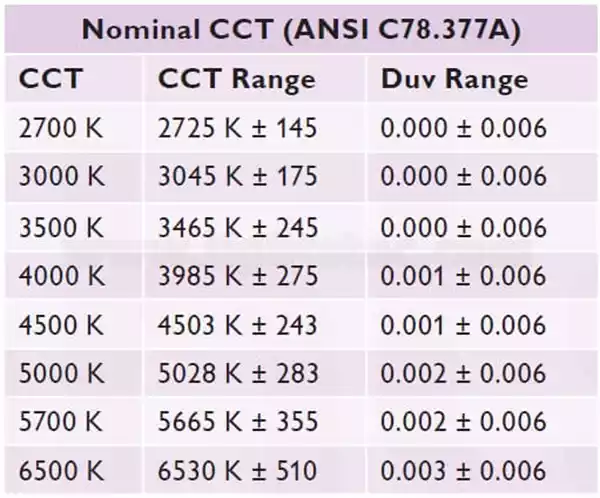How to Choose LED Strip Color Temperature?
-
by Maisie Ou
- Last updated March 7, 2023
Table of Contents
LED strip lights are a versatile and energy-efficient lighting solution that can be used in a variety of settings, from homes and offices to commercial and industrial spaces.
One important factor to consider when choosing LED strip lights is the color temperature.
In this article, we’ll explore what color temperature is, the factors to consider when choosing CCT, and how to choose the right CCT for your needs. What kind of ambiance do you want your space to have? Do you want the home to look warm and welcoming or cold and formal? Also, what sort of CCT will help you achieve your desired effect?
What is the color temperature?
Color temperature is a measure of the color of light produced by a source, measured in Kelvin (K). It describes the color appearance of a light source and is often described as “warm” or “cool.” A lower color temperature, such as 2700K, is considered warm, while a higher color temperature, such as 6500K, is considered cool.

The color temperature of daylight changes during the day, from 2000K at sunrise and sunset to 5500-6500K at noon. In the shade it can even go up to 8000-10000K.

Correlated color temperature vs color temperature?
Correlated color temperature (CCT) is a more accurate measure of the color of light produced by a source. It takes into account the color appearance of the light as well as the spectral distribution of the light. While color temperature is a useful measure for comparing different light sources, CCT is a more accurate measure for selecting LED strip lights.

Factors to consider when choosing CCT
There are several factors to consider when choosing CCT for your LED strip lights, including brightness, effects on human feelings, and adjustable CCT.
3.1 Brightness
CCT does not directly affect the brightness of an LED strip light. The brightness of an LED strip light is measured in lumens. When comparing LED strip lights with different CCTs, it’s important to compare the lumens to determine the brightness of the light.
3.2 Effects of CCT on human feelings
CCT can have a significant impact on the mood and atmosphere of a space. Warmer color temperatures, such as 2700K or 3000K, are often used in residential settings and can create a cozy and relaxing atmosphere. Cooler color temperatures, such as 4000K or 6500K, are often used in commercial settings and can create a brighter and more energizing atmosphere.
3.3 Adjustable CCT
Some LED strip lights have an adjustable CCT, which allows you to change the color temperature of the light to suit your needs. This is particularly useful if you’re using LED strip lights in a space that has different lighting needs at different times of the day.
Are you also thinking, is there a kind of LED light strip CCT that can be adjusted according to your needs? Yes, our CCT adjustable LED strip can meet your needs.
How to choose the right CCT?
When choosing the right CCT for your LED strip lights, consider the following:

4.1 When to choose extra warm white 2700K?
Extra warm white LED strip lights with a CCT of 2700K are best suited for residential settings, such as living rooms, bedrooms, and dining rooms. They create a cozy and relaxing atmosphere and are ideal for creating a warm and welcoming environment.
4.2 When to choose warm white 3000K?
Warm white LED strip lights with a CCT of 3000K are also suited for residential settings but are slightly brighter than extra-warm white lights. They are ideal for kitchens, bathrooms, and other areas where a brighter light is needed but a warm and inviting atmosphere is still desired.
4.3 When to choose neutral white 4000K?
Neutral white LED strip lights with a CCT of 4000K are best suited for commercial settings, such as offices, retail stores, and warehouses. They provide a bright, white light that is ideal for task lighting and can help improve productivity.
4.4 When to choose cool white 6500K?
Cool white LED strip lights with a CCT of 6500K are also best suited for commercial settings, particularly in areas where a very bright light is needed, such as hospitals, laboratories, and factories.
Why does the same CCT LED light look different?
While CCT is a useful measure for selecting LED strip lights, it’s important to keep in mind that the same CCT LED light can look different depending on the manufacturer or the quality of the LED chips used. This can be due to several factors, including test equipment, CCT tolerance, and Duv.
5.1 Test equipment
Different test equipment can produce different results when measuring the CCT of an LED strip light. This can result in inconsistencies between LED strip lights from different manufacturers.

5.2 CCT tolerance
LED strip lights have a CCT tolerance, which is the range of color temperatures that the light can produce while still being considered a certain CCT. For example, an LED strip light with a CCT of 3000K may have a tolerance of +/- 200K. This means that the actual color temperature of the light could be anywhere between 2800K and 3200K.

5.3 Duv
Duv, or the deviation of the uniformity of color, is another factor that can affect the appearance of an LED strip light with the same CCT. It describes the variation in the color of the light compared to a perfect black body radiator of the same CCT. A high Duv value can make the light appear more blue or more red than expected.

FAQ
LED strip color temperature refers to the appearance of the light produced by the LED strip, ranging from warm white to cool white. It is measured in degrees of Kelvin (K).
The available color temperature options for LED strips typically range from 2200K to 6500K. Warmer color temperatures are usually around 2200K-3000K, neutral white around 4000K, and cooler color temperatures are typically around 5000K-6500K.
Yes, LED strip color temperature can affect mood. Warmer color temperatures (2200K-3000K) tend to create a more relaxed and cozy atmosphere, while cooler color temperatures (5000K-6500K) tend to be more energizing and suitable for task-oriented environments.
The color temperature of an LED strip is usually indicated on the product packaging or in the product specifications. If this information is not available, you can also use a color temperature meter or consult the manufacturer’s website.
It depends on the type of LED strip. Some LED strips come with color temperature adjustment features, while others have a fixed color temperature. If you want to change the color temperature of your LED strip, you will need to purchase one with adjustable color temperature or use additional color filters or diffusers to change the hue of the light.
For a bathroom, it’s recommended to use LED strips with a neutral white color temperature (around 4000K) to provide bright and natural-looking light. You may also want to consider installing dimmers to adjust the brightness and create a relaxing atmosphere for soaking in the tub.
For a kitchen, it’s recommended to use LED strips with a cooler color temperature (around 5000K) to provide bright and energizing light for cooking and food preparation tasks. You may also want to consider installing under-cabinet lighting to provide additional task lighting.
Yes, LED strip color temperature can affect color accuracy. Cooler color temperatures (5000K-6500K) tend to provide better color rendering and accuracy, while warmer color temperatures (2200K-3000K) can distort colors and make them appear more yellow or orange.
Color temperature refers to the appearance of the light produced by an LED strip, while color rendering index (CRI) refers to the ability of a light source to accurately reproduce colors compared to natural light. A high CRI value (typically above 80) means that the light source provides better color accuracy and rendering, while a lower CRI value may result in color distortion or a grayish tint.
It depends on the intended use of the LED strip. If you need bright, task-oriented lighting, you may want to prioritize brightness over color temperature. If you want to create a certain mood or atmosphere, you may want to prioritize color temperature over brightness.
Yes, you can use different color temperature LED strips in the same room to create different lighting effects or to highlight different areas or features.
Warm white LED strip color temperatures (2200K-3000K) produce a yellowish or reddish glow similar to incandescent bulbs, while cool white LED strip color temperatures (5000K-6500K) produce a bluish or whitish glow similar to natural daylight.
The best color temperature for different rooms in a house may vary depending on the specific purpose of the room and the desired atmosphere. For example, warmer color temperatures (2200K-3000K) are ideal for creating a cozy and relaxing atmosphere in bedrooms and living rooms, while cooler color temperatures (5000K-6500K) are better for task lighting in kitchens and workspaces.
The main factors to consider when choosing LED strip color temperature are the intended use of the light, the mood and atmosphere you want to create, and the surrounding decor and color scheme.
Conclusion
choosing the right CCT for your LED strip lights requires careful consideration of factors such as brightness, effects on human feelings, and adjustable CCT. It’s also important to keep in mind that the same CCT LED light can look different depending on the manufacturer or the quality of the LED chips used, due to factors such as test equipment, CCT tolerance, and Duv. By taking these factors into account, you can choose LED strip lights that will provide the right color temperature and atmosphere for your space.
MSHLED is a professional LED strip manufacturer, and we package LED beads ourselves. We provide professional color-matching services and customized CCT to our customers.
Related Posts
Get in Touch with Us Now!
Do you have questions or feedback? We’d love to hear from you! Just fill out the form below, and our friendly team will respond ASAP.



